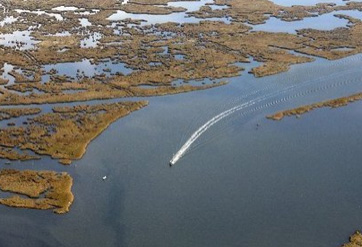Corrosive saltwater from a network of oil and gas access and pipeline canals has killed vegetation and swept away vast amounts of soil, the Southeast Louisiana Flood Protection Authority-East's board of commissioners claims in the lawsuit, which was filed Wednesday in Orleans Parish Civil District Court.
The wetlands are considered a crucial buffer against hurricanes because they can help keep storm surge floodwaters at bay.
"What remains of these coastal lands is so seriously diseased that if nothing is done, it will slip into the Gulf of Mexico by the end of this century, if not sooner," the lawsuit says.
Oil and gas industry leaders and Gov. Bobby Jindal were highly critical of the lawsuit. Jindal's office issued a statement Wednesday night saying the governor demands the lawsuit be withdrawn. He questioned the legality of the board's contract with its lawyers and referred to the suit as a "trial lawyer windfall."
The board says it will have to bear many of the costs associated with the need for increased flood protection. The lawsuit, a draft of which was provided to The Associated Press before it was filed, seeks unspecified damages.
"Even the industry recognizes they are responsible for some of the land lost, and it's not an insignificant amount," said board vice president John Barry, author of "Rising Tide: The Great Mississippi Flood of 1927 and How It Changed America."
About 100 companies are named as defendants in the lawsuit, including Apache Corp., BP America Production Co., Chevron USA Inc., ConocoPhillips Co., Exxon Mobil Corp., Shell Oil Co. and The Pickens Co. Inc.
Officials in the oil and gas industry said they will vigorously defend against the lawsuit.
A statement from Chris John, president of the Louisiana Mid-Continent Oil and Gas Association, said the industry has been involved in trying to fight coastal erosion, a phenomenon he said involves "both natural changes and many man-made activities."
John called it "a contingency lawsuit where the plaintiff attorneys stand to gain millions of dollars."
Jindal said in his statement that the board had overstepped its authority by filing suit against nearly 100 companies, effectively taking on the role of the governor, attorney general and environmental entities in determining the state's policy on coastal issues.
The flood control board covers most of the New Orleans area, governing the Orleans Levee District, the Lake Borgne Basin Levee District and the East Jefferson Levee District.
A protective buffer that took 6,000 years to form "has been brought to the brink of destruction over the course of a single human lifetime," the draft of the suit alleges.
"Unless immediate action is taken to reverse these losses and restore the region's natural defense, many of Louisiana's coastal communities will vanish into the sea," it says. "Meanwhile, inland cities and towns that once were well insulated from the sea will be left to face the ever-rising tide at their doorsteps."
The suit says the U.S. Geological Survey has determined that "altered hydrology" associated with oil and gas activities is one of the primary causes of coastal land loss.
"The increased storm surge risk resulting from the extensive and continuing land loss in southeast Louisiana ... has required, and will continue to require, increased flood protection at increasingly high cost," the suit says.
Local levee districts will bear increasing responsibility for the operation and maintenance of the multibillion-dollar system of gates, walls and armored levees that the U.S. Army Corps of Engineers has built following Hurricane Katrina in 2005, according to the suit.














 The oil and gas industry has cost Louisiana hundreds of thousands acres (hectares) of
The oil and gas industry has cost Louisiana hundreds of thousands acres (hectares) of